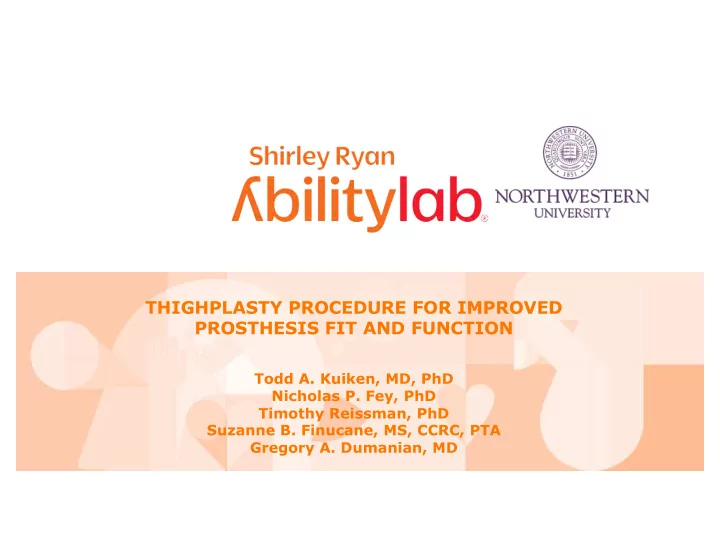

THIGHPLASTY PROCEDURE FOR IMPROVED PROSTHESIS FIT AND FUNCTION Todd A. Kuiken, MD, PhD Nicholas P. Fey, PhD Timothy Reissman, PhD Suzanne B. Finucane, MS, CCRC, PTA Gregory A. Dumanian, MD
BACKGROUND 2
THE CHALLENGE: FAT RESIDUAL LIMBS Facts 2/3 of Americans are overweight • 1/3 are obese • Subcutaneous fat is soft • ‒ It has low compliance ‒ This reduces efficiency and control of this important interface Residual limbs with excess fat are more difficult to fit • ‒ Hard to pull soft tissues into sockets ‒ Hard to grab skeletal structures § Distal femur § Ischium Residual limbs with excess fat have more complications • ‒ Pain from tissues hanging over walls ‒ Sores from walls not getting into the socket ‒ Worse prosthesis control due to compliant interface Very few people lose significant amounts of weight •
WHY NOT PERFORM SURGERY TO REMOVE EXCESS FAT? Options: -Thighplasty -Liposuction Change the human to better fit the technology. 4
COMPREHENSIVE CASE STUDY Pre- and post-thighplasty Obese transfemoral amputee § 1. Tissue distribution MRI § 2. Socket-limb stiffness 2 kinds of sockets tested § 3. Comprehensive Outcomes Clinical, questionnaire, § metabolics 5
TISSUE DISTRIBUTION AND SURGERY Patient was an • overweight 50-year-old Hispanic female (adjusted BMI of 29) Had a right transfemoral • amputation over 35 years ago secondary to osteosarcoma Tissue removal liposuction § (2 liters; 2042 g, 4.5 lbs) Tissue removal medial § excision (772.5 g, 1.7 lbs) Total: 6.2 lbs § 6
RESULTS 7
APPEARANCE Pre Limb circumference proximal mid distal 65 58 54cm pre 64 55 47cm post Post 8
APPEARANCE Pr Pre Po Post Amputated leg is now smaller than her intact limb, even with her prosthesis on. 9
PRE- AND POST-OPERATIVE MRI Image 5: Pre-op Image 4: Pre-op 5 4 Image 5: Post-op Image 4: Post-op 10
INFLUENCE ON TISSUE DISTRIBUTION 11
CLINICAL OUTCOMES OF PATIENT PRE- AND POST-SURGERY Pre- Post- % A. Clinical Outcome Surgery surgery Improvement 10-Meter Walk Test 0.76 0.80 +5.3 (comfortable, m/s) 10-Meter Walk Test (fast, 1.01 1.01 0 m/s) 6-Minute Walk Test (ft.) 1202 1339 +11.4 5-times Sit-to-Stand Test 17.11 12.88 +24.7 (sec.) 4-Square Step Test (sec.) 9.80 7.73 +21.1 4-Square, half prosthesis 4.62 3.21 +30.6 inside (sec.) 4-Square, half prosthesis 4.78 3.54 +26.1 outside (sec.) 12
X-RAY FOR DISPLACEMENT 1 1. Erikson and James 1973 13
INTERFACE STIFFNESS AND INFLUENCE OF SOCKET GEOMETRY Isometric patient loading while § weight-bearing 6-axis load cell § Visual feedback of load target § Compute multi-axis stiffness § 1. Fey et al. ASB 2015 14 2. Fey et al. EMBC 2015
INTERFACE STIFFNESS AND INFLUENCE OF SOCKET GEOMETRY § Isometric patient loading while weight-bearing § 6-axis load cell § Visual feedback of load target § Compute multi-axis stiffness 1. Fey et al. ASB 2015 15 2. Fey et al. EMBC 2015
FEMUR ORIENTATION Ischial Sub-Ischial Containment Containment Pr Pre-Op Op Isch. Sub Cont. Isch. Pre 8.13º 6.81º Post 4.14º 2.09º Po Post-Op Op 16
PRE- AND POST- STIFFNESS DATA IN SUB-ISCHIAL SOCKET Pre- Post- % Units surgical Surgical Change Axial 19 (0.81) 28 (2.9) N/mm +47.3 Frontal (medial) 160 (6.5) 261 (13) Nm/rad +63.1 Frontal (lateral) 610 (38) 545 (38) Nm/rad -10.7 Sagittal (anterior) 170 (5.0) 310 (20) Nm/rad +82.2 Sagittal (posterior) 470 (20) 502 (13) Nm/rad +6.8 Po Potential influence ce of limb length (S^3 ^3) or E? 17
CLINICAL OUTCOMES AND QUESTIONNAIRE Pre- Post- % Improvement Clinical Outcomes 10-meter walk test (comfortable, m/s) 0.76 0.80 5.3 10-meter walk test (fast, m/s) 1.01 1.01 0.0 6-minute walk test (ft.) 1202 1339 11.4 5 times sit-to-stand test (sec.) 17.11 12.88 24.7 4-square step test (sec.) 9.80 7.73 21.1 4-square, half prosthesis inside (sec.) 4.62 3.21 30.6 4-square, half prosthesis outside (sec.) 4.78 3.54 26.1 Patient Questionnaire (1-7, 1=strongly agree, 4=neither agree nor disagree, 7 strongly disagree) Pre- Post- Change Is your socket painful to wear? 3 7 4 Is your socket easy to put on? 1 1 0 Are you able to wear your socket for long periods of time? 3 1 2 Is your socket comfortable while seated? 2 1 1 Is it easy to go from sitting to standing in your socket? 2 1 1 Does your socket affect your ability to walk in your home? 3 7 4 Does your socket affect your ability to walk in the community? 3 7 4 Does your socket affect the distance you can walk in the community? 1 7 6 Do you feel you have good control of your prosthesis with this socket? 7 1 6 Do you feel stable on your prosthesis with this socket? 3 1 2 Do you like the look/shape of your socket? 7 5 2 18
METABOLIC AND SPEED OUTCOMES WITH ISCHIAL CONTAINMENT SOCKET Pre-Surgery Post-Surgery 1600 1600 1400 1400 1200 1200 1000 1000 800 800 600 600 400 400 200 200 0 0 0 200 400 600 800 1000 0 200 400 600 800 Speed (m/min) Pre Post Units % change Pre Comfortable 51.9 (2.04) E Comfortable 8.20 (2.66) 6.65 (1.33) mL/min/kg -18.9 Pre Fast 67.1 (1.72) E Fast 11.73 (3.18) 8.03 (1.64) mL/min/kg -33.5 Post Comfortable 58.8 (0.63) COT Comfortable 0.158 (0.05) 0.113 (0.023) mL/kg/m -28.5 Post Fast 70.1 (2.32) COT Fast 0.175 (0.05) 0.115 (0.026) Nm/kg/m -34.5 19
IMPLICATIONS 20
DO DATA SUPPORT THE USE OF THIGHPLASTY? § Volume and cosmesis Yes § Fat reduction Yes § Anatomical femur containment Yes § Questionnaire Yes § Walking distance, long distance Yes § Walking speed, short distance Same § Maneuverability Yes § Sit-to-stand Yes § Stiffness For subischial § Metabolics Yes 21
FURTHER IMPLICATIONS • May allow amputees to use sockets they previously could not wear • Shifts the focus of research from external devices to improving the human residual limb to work with a prosthesis—an area with little research to date • Procedure may help inform future clinical care for amputees 22
Recommend
More recommend